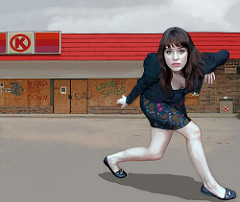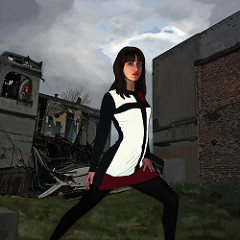In 2007, two years after Katrina, I did a series of 4 digital paintings titled "Betsy McCall, Ready for (Almost) Anything in Post Katrina NOLA". My initial concern with Katrina had been the disconnect from NOLA based on class and the victimization of the populations most vulnerable to such disasters, racially and economically. How this concern became blended with "models" posing amidst the ruins came about through several stages of thought.
First I should perhaps say something about the "how" of the images before getting into the "why". In 2006 I traveled through NOLA and coastal areas hard struck by Katrina that had received less attention in the news. My husband is a musician, and having visited NOLA numerous times I wanted to see what had transpired during the year, fully aware the devastation was still fresh and many still displaced, including many friends and relatives. My husband, though he was born in New Orleans, didn't grow up in New Orleans. However, his family had for generations been a coastal Louisiana family, he had relations in New Orleans whose homes had been rendered uninhabitable by Katrina and had been unable to return to NOLA as yet, and he had spent part of his youth in another area we knew to have been razed by Katrina. When we reached it we found that the neighborhood of his youth had been obliterated.
The base for these digital paintings are my 2006 photographs of NOLA and photos of a model that, unrelated to Katrina, had been uploaded to a website called Deviant Art.
Unless you're familiar with certain fashion and cultural icons of the 60s, it's perhaps unlikely that you might see a resemblance between the Deviant Art model and Jane Birkin. She's the woman on the far right in the blue, green and white dress. Not the best photo to use of her, and I shall change it out, but it is the one I happen to have screen-grabbed of her that is on my computer.

Jane Birkin was in the Antonioni film "Blow-up", which had a certain influence on this series of paintings. The film begins with a photographer disguising himself as a homeless man, for the purpose of gaining close access to and photographing individuals and settings outside his commercial territory as a fashion photographer. As the movie reveals, his real understanding of these individuals and settings is vacuous and his use of them is opportunistic. He is also an individual who tends toward abusive and misogynistic behavior with the women who model for him. The arc of a personal awakening for him in the film is when he inadvertently photographs something he wasn't intended to see. What seems his intentional intrusion on the intimate meeting of a man and a woman in a park turns out to be instead the unintentional capture of a murder scene, but he is helpless to make anyone believe him. His physical boundaries are threatened and he undergoes a certain psychic disintegration as he goes from being a victimizer to one who is victimized.
As I looked at my photographs of New Orleans, it occurred to me that such a scene was going to be opportunistically reframed into fashion photo shoots in the future.
Much about Hurricane Katrina centers on preparedness, this preparedness didn't happen, and why did it not.
I was not a child who played with dolls, but I flashed back on a time when, at the age of five, I went through a brief fascination with Betsy McCall paper dolls, making my own and drawing and cutting out clothing for them. The message, as with Barbie, was that preparedness was nine-tenths being able to have the right clothes. Every situation demanded the proper attire for survival. This was so impressed that it seemed as though, with the just-right clothing and shoes, the appropriate "look", one could survive anything. What one learns as one becomes a little older is that clothing and fashion demand money. Of course. The appropriate style for survival means having the wealth, but this is often only conveyed indirectly.
If one had only the bank account, investments, savings, then one would be prepared.
If one had only the right job.
If one had only the right education.
If one had only made use of their opportunities.
If one had only done this.
If one had only done that.
If only...then one wouldn't have died. One would have had the wealth, and the rights and privileges accorded wealth, to survive.
Fashion and the idea of a fashion shoot in the midst of devastation may seem a surface approach to take to the problems of privilege, but fashion and style are high stakes propositions especially for those without money. Our culture is inundated with images of not only that which makes a person worth-while, but that which makes one a "person", and those things which grant the right to be a "person" are afforded by privilege and wealth.
Fashion and clothing are often represented as a kind of armor that can meet and conquer any situation, media boosting fashion as making individuals powerful by virtue of their clothing and ornamentation. And I could easily imagine fashion eventually traipsing models through ruined global warming landscapes in a demonstration of the power of the well-prepared (monied) who are as invulnerable as the staunchest super heroes. But would men likely be posed among such ruins? No, it was likely to be women who are presented often as little more than cut-out paper dolls.
I was also observing at the time, in certain internet forums, how youth so broadly accepted various types of fashion as not just representing empowerment but being empowerment in a manner that had nothing to do with women as strong individuals but, again, as little more than mannequins–and, most frequently, abused mannequins, or, absurdly, "power" mannequins bound and gagged in sado-masochistic fantasies. Not that this is anything new, but the relatively cheap availability of artistic tools such as DLSR cameras and Photoshop meant a proliferation of fantasy scenarios most frequently involving vulnerable women.
As stated above, I had already put two and two together and thought that it was only natural we would eventually be seeing fashion shots against future real life cataclysms, scenes of devastation as perfect backdrops to these absurd fetishes of women whose fashion choices (class and money) made them invincible goddesses, and yet what is equated with empowering can be impractical to the point of utilitarian ineffectiveness, and worn by affectless, voiceless and powerless women.
An every-day runway example would be models carefully striding on "power" shoes, which aren't built for walking, toppling off them, scrambling to upright themselves and being lucky not to break an ankle in the process. From where does the idea of power emanate in this hobbling? Is it the strict restraint and inability to do anything (not a part of the working class) that communicates power in these fashion idols? An ivory tower disregard? A bubble effect wherein these supposed fashion power goddesses can glide through devastation and be absolutely unscathed, their unstained dresses glowing white, their make-up pristine, and, again, their expressions largely removed and disconnected?
The fashion model thus became to me the means of expressing the lie of preparedness for the majority, the great divide between those who are unable to escape, who must live with what has been wrought, and those who are afforded safety through wealth, a safety that is expressed via vulnerable, young women who disappear within the theatrical garb of fashion even as it supposedly elevates them out of the paws of fate and above the teeming throng of humanity. Because fashion and its promise of invulnerability is also directed at all levels of class, rather than going with high fashion I chose to have the models in everyday attire, communicating fashion instead with the aesthetic of the pose. I wanted the model to bridge the inviolate and the victim as someone who is typically insusceptible and thus has found assurance in the promise of preparation, but not so safe as to be unthreatened. She needed a touch of uncertainty and discomfort.
Women, as fashion models, may represent power but are often powerless. Even Jane Birkin, in her interviews, allows that some of what she did, which made her uncomfortable, was for the purpose of pleasing the men in her life.
Because I could so easily imagine disaster areas becoming landscapes for photo shoots, I was of course very interested in Vogue's 2013, "Storm Troopers: Celebrating Hurricane Sandy's First Responders", shot by Annie Leibovitz and using models with Hurricane Sandy responders against the devastation of the hurricane. The lead in paragraph to the Vogue article illustrated what I'd written above on fashion as power, however hobbled and removed in its bubble effect: "When Hurricane Sandy hit, the city's bravest and brightest punched back. With the area now on the mend, we paid these stalwart souls a visit, dressed up in the best of the New York collections. Call them New York's other finest." A parallel was being drawn between fashion and the responders, the "city's bravest and brightest". Or at least a feeble effort was being made. For it doesn't work. The parallel is a fatuous one, for the models in their power fashions were not meant to be on par with the responders. They stood out against the scenes as goddesses descending from on high, scarcely interacting, their peculiar mystique presented not only as a kind of morale builder but fashion's "power woman" penultimate example of a job so well done that the cut out paper doll, ready for anything in her power fashion gear, is untouched by flame and flood.






